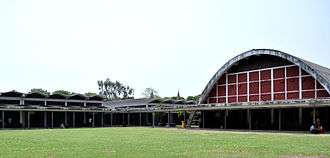Constantinos Apostolou Doxiadis
Constantinos A. Doxiadis[lower-alpha 1] (also Konstantinos; 14 May 1913 – 28 June 1975), often cited as C. A. Doxiadis, was a Greek architect and town planner. He was known as the lead architect of Islamabad, the new capital of Pakistan in the 1960s, and later as the father of Ekistics, which concerns the science of human settlements[2].
C. A. Doxiadis | |
|---|---|
| Born | May 14, 1913 |
| Died | 28 June 1975 (aged 62) Athens, Greece |
| Nationality | Greek |
| Occupation | Architect, Town Planner |
| Awards | see awards section |
| Practice | Doxiadis Associates |
| Buildings | Teacher-Student Centre, University of Dhaka |
| Projects | Islamabad, Riyadh |
Theories
Doxiadis is the father of 'Ekistics', which concerns the science of human settlements, including regional, city, community planning and dwelling design[2]. The term was coined by Doxiadis in 1942 and a major incentive for the development of the science is the emergence of increasingly large and complex settlements, tending to regional conurbations and even to a worldwide city. However, ekistics attempts to encompass all scales of human habitation and seeks to learn from the archaeological and historical record by looking not only at great cities, but, as much as possible, at the total settlement pattern.
Doxiadis also coined the term 'entopia', coming from the Greek word έν (“in”) and τόπος (“place”). He quoted "What human beings need is not utopia ('no place') but entopia ('in place') a real city which they can build, a place which satisfies the dreamer and is acceptable to the scientist, a place where the projections of the artist and the builder merge." .

Influence
In the 1960s and 1970s, urban planner and architect Constantinos Doxiadis authored books, studies, and reports including those regarding the growth potential of the Great Lakes Megalopolis.[3] At the peak of his popularity, in the 1960s, he addressed the US Congress on the future of American cities, his portrait illustrated the front cover of Time Magazine, his company Doxiadis Associates was implementing large projects in housing, urban and regional development in more than 40 countries, his Computer Centre (UNIVAC-DACC) was at the cutting edge of the computer technology of his time and at his annual "Delos Symposium" the World Society of Ekistics attracted the worlds foremost thinkers and experts.
In Greece, he faced persistent suspicion and opposition and his recommendations were largely ignored. Having won two large contracts (National Regional Plan for Greece and Master Plan for Athens) from the Greek Junta he was criticised by competitors, after its fall in 1974, portrayed as a friend of the colonels. His visions for Athens airport to be constructed on the adjacent island of Makronissos, where political prisoners were held, together with a bridge, a rail link and a port at Lavrion were never realised.
His influence had already diminished at his death in 1975, as he was unable to speak for the last two years of his life, a victim of amyotrophic lateral sclerosis (ALS).[4] His company Doxiadis Associates changed owners several times after his death, the heir to his computer company remained but without any links to planning or ekistics. The Delos Symposium was discontinued, and the World Society of Ekistics is today an obscure organisation.
Works about Doxiadis have appeared in the Museum of Brisbane, Milani Gallery, Brisbane and feature in the To Speak of Cities exhibition at the University of Queensland Art Museum[5][6].
Works
One of his best-known town planning works is Islamabad. Designed as a new city it was fully realised, unlike many of his other proposals in already existing cities, where shifting political and economic forces did not allow full implementation of his plans. The plan for Islamabad, separates cars and people, allows easy and affordable access to public transport and utilities and permits low cost gradual expansion and growth without losing the human scale of his "communities".
Doxiadis's work in Riyadh and elsewhere represented what one anthropologist has called "containment urbanism," that is to say policies aimed at integrating rural masses migrating to cities and thus prevent the emergence of subversive political movements. In Riyadh, Doxiadis reoriented the city on a southwest-northeast access, rendering "the planned city...similar to an immense mosque facing Mecca." [7] His work was also part of the architecture event in the art competition at the 1936 Summer Olympics.[8]

- The Sacrifices of Greece in the Second World War (exhibit, San Francisco City Hall, 1945)
- Master Plan of Islamabad, The capital of Pakistan;1960
- Teacher-Student Centre (TSC), University of Dhaka, Bangladesh; 1961
- Master Plan of the Yellow Line Expressway in Rio de Janeiro, early 1960s.
Awards
His awards and decorations are as follows[9]:
- Greek Military Cross, for his services during the war 1940-41 (1941)
- Order of the British Empire, for his activities in the National Resistance and for his collaboration with the Allied Forces, Middle East (1945)
- Order of the Cedar of Lebanon, for his contribution to the development of Lebanon (1958)
- Royal Order of the Phoenix for his contribution to the development of Greece (1960)
- Sir Patrick Abercrombie Prize of the International Union of Architects (1963)
- Cali de Oro (Mexican Gold Medal) Award of the Society of Mexican Architects (1963)
- Award of Excellence, Industrial Designers Society of America (1965)
- Aspen Award for the Humanities (1966)
- Yugoslav Flag Order with Golden Wreath (1966)
Publications by Doxiadis
Books
- Dynapolis The City Of The Future (1960)[10]
- Doxiadis, Constantinos A. (1966). Emergence and Growth of an Urban Region: The Developing Urban Detroit Area. Detroit: Detroit Edison.
- Doxiadis, Constantinos A. (1966). Urban Renewal and the Future of the American City. Chicago: Public Administration Service.
- Doxiadis, Constantinos A. (1968). Ekistics: An Introduction to the Science of Human Settlements. New York: Oxford University Press.
- Doxiadis, Constantinos A. (1974). Anthropopolis: City for Human Development. New York: W.W. Norton.
- Doxiadis, Constantinos A.; Papaioannou, J.G. (1974). Ecumenopolis: The Inevitable City of the Future. Athens: Athens Center of Ekistics.
- Doxiadis, Constantinos A. (1975). Building Entopia. Athens: Athens Publishing Center.
- Doxiadis, Constantinos A. (1976). Action for Human Settlements. New York: W.W. Norton.
Journal articles
- Doxiadis, Constantinos A. (1965). "On Linear Cities" (PDF). Town Planning Review. 36 (1): 1. doi:10.3828/tpr.36.1.f4148303n72753nm.
- Doxiadis, Constantinos A. (1967). "Islamabad, the creation of a new capital". Town Planning Review. 38 (1): 35. doi:10.3828/tpr.38.1.70733287173p06k8.
- Doxiadis, Constantinos A. (1968). "Man's Movement and His City". Science. 162 (3851): 326–334. doi:10.1126/science.162.3851.326. PMID 17836649.
Publications on Doxiadis
- Kyrtsis, Alexandros-Andreas (2006). Constantinos A. Doxiadis: texts, design drawings, settlements. Athens: Ikaros
- Tsiambaos, Kostas (2018). From Doxiadis' Theory to Pikionis' Work: Reflections of Antiquity in Modern Architecture. London & New York: Routledge.
- Amygdalou, K., Kritikos, C. G., Tsiambaos, K. (2018). The Future as a Project: Doxiadis in Skopje. Athens: Hellenic Institute of Architecture.CS1 maint: multiple names: authors list (link)
See also
Notes
- Greek: Κωνσταντίνος Αποστόλου Δοξιάδης, pronounced [konstanˈdinos apoˈstolu ðoksiˈaðis].
References
- Saxon, Wolfgang (June 29, 1975). "Constantinos Doxiadis, City Planner, Is Dead at 62". The New York Times. Retrieved 15 May 2020.
- Doxiadis, Constantinos Apostolos. (1968). Ekistics : an introduction to the science of human settlements. Oxford University Press. OCLC 441332859.
- Cities: Capital for the New Megalopolis.Time magazine, November 4, 1966. Retrieved on July 16, 2010.
- Biographical Note, Doxiadis.org. Retrieved August 2, 2016.
- Brown, Phil (March 18–24, 2020). "Bold type". Brisbane News. 1267: 15.CS1 maint: date format (link)
- The University of Queensland (2020). "Window commission sparks conversations about future cities". UQ News. Retrieved 2020-03-25.
- Menoret, Pascal (2014). Joyriding in Riyadh: Oil, Urbanism, and Road Revolt. Cambridge, UK: Cambridge University. p. 69.
- "Constantinos Apostolou Doxiadis". Olympedia. Retrieved 11 August 2020.
- https://openlibrary.org/books/OL16592889M/Dynapolis_the_city_of_the_future
External links
| Wikiquote has quotations related to: Constantinos Apostolou Doxiadis |